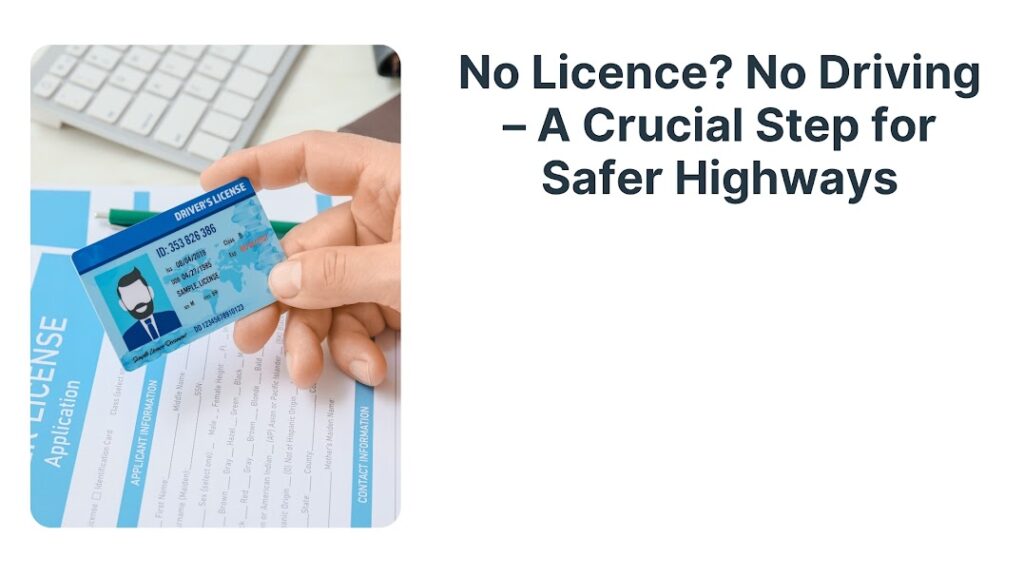In most countries around the world, a driving licence is a legal document that signifies a person’s eligibility and competency to operate a motor vehicle. This document is not merely a formality; it is a gateway to ensuring safety, responsibility, and accountability on the road. The slogan “No Driving Licence, No Drive” is not just a catchy phrase—it’s a fundamental principle that underpins traffic law enforcement systems worldwide. But why is it so important? Why must authorities strictly enforce this rule? And what are the consequences when they don’t? Driving is a privilege, not a right.
This article explores the profound implications of driving without a licence, the role of government and law enforcement agencies in regulating drivers, and how strict enforcement policies contribute to overall public safety.
The Purpose of a Driving Licence
1.1 What a Licence Represents
A driving licence is proof that a person has met specific legal and practical requirements for operating a vehicle. These include:
- Knowledge of traffic laws
- Understanding of road signs and signals
- Ability to drive safely and respond to emergencies
- Awareness of responsibilities as a road user
Without this verification process, unqualified individuals could take to the roads, increasing risks for everyone.
1.2 Regulatory Compliance
Driving without a valid licence is a violation of legal statutes in most jurisdictions. It is a punishable offence that not only indicates non-compliance with traffic laws but also reflects a disregard for public order.
Consequences of Unlicensed Driving
2.1 Road Accidents and Injuries
According to global traffic safety studies, unlicensed drivers are significantly more likely to be involved in fatal accidents. These individuals typically:
- Lack of formal training
- May not understand traffic rules
- Are often uninsured
- Might panic during emergencies
This increases the probability of accidents, endangering the lives of pedestrians, passengers, and other drivers.
2.2 Higher Insurance Costs for Society
When unlicensed drivers cause accidents, victims may struggle to receive compensation, especially if the driver is uninsured. This leads to:
- Higher health care costs
- Increased burden on public resources
- Rising insurance premiums for lawful drivers
2.3 Criminal Activity and Evasion
Driving without a licence is sometimes associated with broader patterns of criminal behaviour. Offenders might also:
- Be driving stolen vehicles
- Be involved in trafficking or smuggling
- Be attempting to evade law enforcement or avoid arrest warrants
Lack of a licence thus acts as a red flag in many criminal investigations.
The Role of Law Enforcement
3.1 Routine Checks and Technology
Police forces use various tools to check for unlicensed drivers, such as:
- Random traffic stops
- Speed cameras
- Automated Licence Plate Recognition (ALPR) systems
- Mobile traffic units with access to licensing databases
These technologies enhance enforcement and deter people from driving without proper documentation.
3.2 Penalties and Legal Action
Authorities have established serious penalties for unlicensed driving, including:
- Hefty fines
- Vehicle impoundment
- Jail time in repeat or severe cases
- Disqualification from obtaining a licence for several years
These sanctions send a clear message: driving without a licence will not be tolerated.
Education and Public Awareness
4.1 Importance of Driver Education
Comprehensive driver training programs play a vital role in reducing unlicensed driving. When citizens are properly educated on road laws and dangers, they’re more likely to comply.
4.2 Role of Schools and NGOs
Driving awareness campaigns in schools and community centres educate young people about the responsibilities of being a driver. NGOs also work to spread awareness through:
- Road safety workshops
- Digital campaigns
- Community outreach programs
4.3 Media and Communication
Public service announcements (PSAs), billboards, and online videos are instrumental in shaping public attitudes toward road safety and licensing requirements.
Challenges in Enforcement
5.1 Corruption and Bribery
In some regions, corruption within law enforcement or transport departments weakens enforcement. Fake licences and bribery allow unqualified individuals to drive freely.
5.2 Resource Constraints
Lack of funding, understaffed police departments, and poor infrastructure can limit enforcement capabilities, especially in rural or remote areas.
5.3 Technological Gaps
Outdated systems may prevent real-time licence verification. Without modern tech, catching unlicensed drivers becomes more difficult.
Solutions for Stronger Enforcement
6.1 Digital Verification Systems
Governments should implement digitised databases accessible by law enforcement in real-time. QR-coded licences and app-based systems improve accuracy and reduce forgery.
6.2 Increased Patrol Presence
More patrol officers, especially at high-risk locations such as highways and school zones, act as a strong deterrent against unlicensed driving.
6.3 Community Involvement
Citizens can report suspicious or reckless drivers. Anonymous tip lines and local watch groups help reinforce the message: “No Licence, No Drive.”
6.4 Cross-Department Collaboration
Coordination between transport authorities, police, insurance providers, and judicial systems ensures consistent and fair enforcement.
Ethical and Social Dimensions
7.1 Equity and Accessibility
Enforcement must be balanced with fairness. Authorities should ensure that licensing processes are:
- Accessible to all citizens
- Affordable and transparent
- Available in multiple languages if needed
7.2 Rehabilitation vs. Punishment
First-time offenders, especially minors, should be guided through education and training rather than harsh penalties. A reformative approach can turn illegal drivers into responsible citizens.
The Role of Technology in the Future
8.1 AI and Smart Surveillance
AI-powered cameras and smart sensors can detect vehicle behaviour and cross-reference licence plates instantly. This will help in:
- Reducing manual checks
- Automating violation reports
- Building a predictive risk profile for repeat offenders
8.2 Mobile Applications
Government apps can:
- Remind users of licence renewal deadlines
- Allow instant digital licence verification
- Alert authorities to expired or fake licences
8.3 Blockchain for Licensing
Future licensing systems may use blockchain for fraud-proof documentation. This ensures the authenticity and traceability of licences across agencies.
The Economic Impact of Unlicensed Driving
9.1 Burden on Legal System
Courts are often clogged with cases involving traffic violations. Reducing unlicensed driving frees up judicial time and resources.
9.2 Lost Revenue for Governments
Driving licence fees contribute to government revenue. Unlicensed drivers avoid these payments, undermining financial systems that support road infrastructure.
9.3 Impact on Businesses
Companies that employ drivers (e.g., logistics, taxis) suffer reputational and financial losses if employees are caught driving without proper licences.
Know more about:- Know the process of Driving Licence renewal in India
Conclusion
The principle of “No Driving Licence, No Drive” is more than a law—it’s a commitment to public welfare. Enforcing this rule protects lives, reduces accidents, and builds a culture of lawful behaviour. Every road user—whether a pedestrian, cyclist, or driver—deserves to feel safe. To achieve that, we must ensure that everyone behind the wheel is qualified, accountable, and legally authorised.
Enforcement is not just about punishment. It’s about education, equity, and empowerment. With the right combination of law, technology, and community awareness, we can move toward safer roads and more responsible drivers.
- No Licence? No Driving – A Crucial Step for Safer Highways
- The principle of “No Driving Licence, No Drive” is more than a law—it’s a commitment to public welfare. Enforcing this rule protects lives, reduces accidents, and builds a culture of lawful behaviour
- driving licence,
Related posts:
 Fitness for Mental Clarity: Unlock Your Focus and Inner Strength with DG FIT MIND
Fitness for Mental Clarity: Unlock Your Focus and Inner Strength with DG FIT MIND
 Top Carrier Oil Suppliers in India for Bulk & Wholesale Buyers
Top Carrier Oil Suppliers in India for Bulk & Wholesale Buyers
 Atlas Pro ONTV : La Révolution de la Télévision par Internet
Atlas Pro ONTV : La Révolution de la Télévision par Internet
 Luxury or Budget? Finding the Right Heathrow Transfer for You
Luxury or Budget? Finding the Right Heathrow Transfer for You
 What Is Cold Rolled Stainless Steel Coil and Why Does It Matter?
What Is Cold Rolled Stainless Steel Coil and Why Does It Matter?
 Make Impact with Commercial Signs Raleigh NC: A Strategic Guide to Business Success
Make Impact with Commercial Signs Raleigh NC: A Strategic Guide to Business Success
 PEX vs Copper in New Homes: What’s Right for You? | Creative Repipe
PEX vs Copper in New Homes: What’s Right for You? | Creative Repipe
 Make Your Message Stick: The Power of Flyers & Posters in Plano!
Make Your Message Stick: The Power of Flyers & Posters in Plano!








